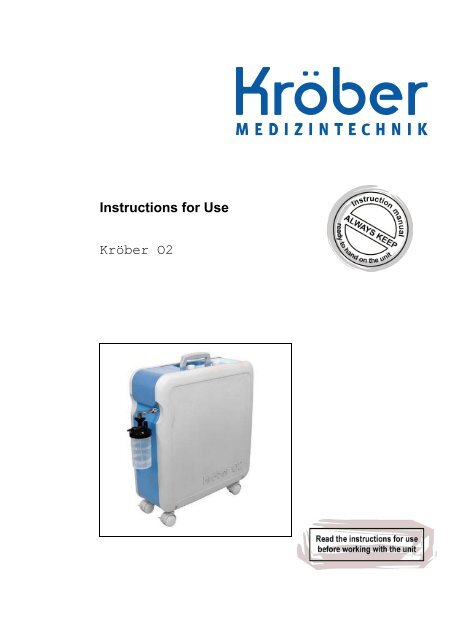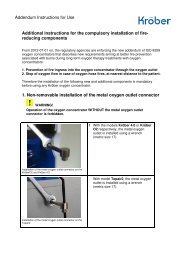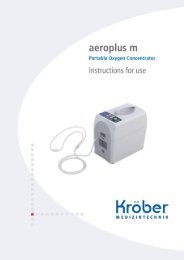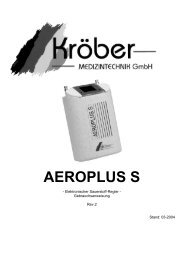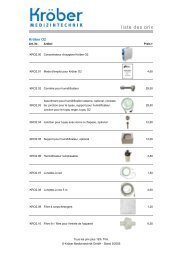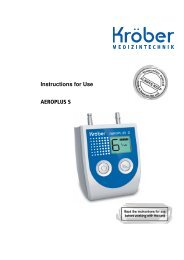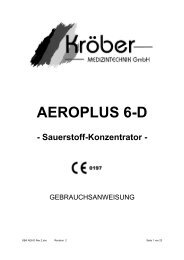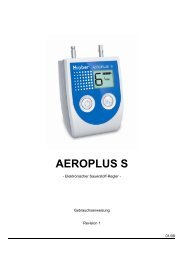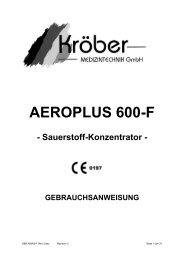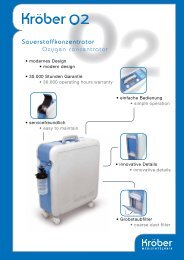Instructions for Use Kröber O2 - Kröber Medizintechnik GmbH
Instructions for Use Kröber O2 - Kröber Medizintechnik GmbH
Instructions for Use Kröber O2 - Kröber Medizintechnik GmbH
Create successful ePaper yourself
Turn your PDF publications into a flip-book with our unique Google optimized e-Paper software.
<strong>Instructions</strong> <strong>for</strong> <strong>Use</strong><br />
Kröber <strong>O2</strong>
Kröber <strong>O2</strong><br />
2<br />
© Kröber <strong>Medizintechnik</strong> <strong>GmbH</strong><br />
Salzheck 4<br />
D-56332 Dieblich<br />
Phone: +49 (0) 2607 9404 0<br />
Fax: +49 (0) 2607 9404 22<br />
E-Mail: info@kroeber.de<br />
Internet: www.kroeber.de<br />
Dok-ID: KR02.00<br />
Rev.: 3
Kröber <strong>O2</strong><br />
3
Kröber <strong>O2</strong><br />
4<br />
1 Preliminary statement ........................................................................................................ 6<br />
2 General................................................................................................................................. 7<br />
2.1 In<strong>for</strong>mation in these instructions <strong>for</strong> use ......................................................................... 7<br />
2.2 Declaration of Manufacturer ........................................................................................... 8<br />
2.3 Type plate....................................................................................................................... 9<br />
2.4 Liability and warranty......................................................................................................9<br />
2.5 Warranty ......................................................................................................................... 9<br />
2.6 Explanation of symbols................................................................................................. 10<br />
2.7 Copyright protection...................................................................................................... 11<br />
2.8 Return and waste disposal ........................................................................................... 11<br />
2.9 Customer service.......................................................................................................... 11<br />
3 Safety ................................................................................................................................. 12<br />
3.1 General......................................................................................................................... 12<br />
3.2 Customer’s responsibility.............................................................................................. 12<br />
3.3 Intended use................................................................................................................. 13<br />
3.4 Dangers which may arise from the unit ........................................................................ 13<br />
3.5 What to do if a hose caught fire.................................................................................... 16<br />
4 Design and function ......................................................................................................... 17<br />
4.1 General description....................................................................................................... 17<br />
4.2 Design........................................................................................................................... 17<br />
5 Technical data ................................................................................................................... 19<br />
6 Transport, packaging and storage .................................................................................. 21<br />
6.1 Transport inspection ..................................................................................................... 21<br />
6.2 Storage ......................................................................................................................... 21<br />
7 Taking into service ...........................................................................................................22<br />
7.1 Be<strong>for</strong>e assembling........................................................................................................ 22<br />
7.2 Choosing the location ................................................................................................... 23<br />
7.3 Assembly ...................................................................................................................... 24<br />
7.3.1 Without external humidification............................................................................... 24<br />
7.3.2 With external humidification ................................................................................... 26
Kröber <strong>O2</strong><br />
8 Operation............................................................................................................................28<br />
8.1 Taking into service ....................................................................................................... 28<br />
8.2 Adjusting the oxygen volume flow ................................................................................ 29<br />
8.3 Alarms .......................................................................................................................... 30<br />
8.3.1 Alarm priorities ....................................................................................................... 30<br />
8.3.2 Alarm categories .................................................................................................... 31<br />
9 Maintenance.......................................................................................................................35<br />
9.1 Safety ........................................................................................................................... 35<br />
9.2 General notes...............................................................................................................35<br />
9.2.1 Cleaning ................................................................................................................. 35<br />
9.2.2 Disinfecting............................................................................................................. 35<br />
9.3 Maintenance plan ......................................................................................................... 36<br />
9.4 Maintenance work ........................................................................................................ 38<br />
10 Spare parts.......................................................................................................................40<br />
11 Appendix ..........................................................................................................................41<br />
11.1 EMC regulations......................................................................................................... 41<br />
11.1.1 Electromagnetic compatibility, interference emission .......................................... 41<br />
11.1.2 Electromagnetic compatibility, interference emission .......................................... 42<br />
11.1.3 Recommended safety distances .......................................................................... 45<br />
11.2 Explanation of symbols on the unit............................................................................. 46<br />
12 Index .................................................................................................................................48<br />
5
Kröber <strong>O2</strong><br />
Preliminary statement<br />
6<br />
1 Preliminary statement<br />
Your doctor has found that you require an additional oxygen supply. With the Kröber <strong>O2</strong><br />
you received a German brand product <strong>for</strong> oxygen supply, which has been developed on the<br />
basis of the latest knowledge in both medical engineering and electronics. Permanent quality<br />
inspections ensure uni<strong>for</strong>m quality on the highest level.<br />
The Kröber <strong>O2</strong> is a highly reliable oxygen concentrator , intended <strong>for</strong> use in homes or at<br />
home, as well as <strong>for</strong> clinical applications.<br />
However, should problems arise with the Kröber <strong>O2</strong>, you may contact your dealer at any<br />
time.<br />
This medical care product from Kröber is labelled with the CE-sign according to MPG<br />
(Medical Product Law).<br />
Only use the Kröber <strong>O2</strong> after a medical indication and only in compliance with the<br />
doctor's orders by following these instructions <strong>for</strong> use.<br />
If side effects or extreme health restrictions occur during the therapy, you should<br />
immediately consult your doctor.
2 General<br />
2.1 In<strong>for</strong>mation in these instructions <strong>for</strong> use<br />
Kröber <strong>O2</strong><br />
General<br />
These instructions <strong>for</strong> use describe the installation, operation and maintenance of the unit.<br />
Strict compliance with the stated notes on safety and instructions <strong>for</strong> use is a prerequisite <strong>for</strong><br />
safe and proper work with the unit.<br />
Moreover, compliance with the accident prevention instructions valid at the location of use<br />
and the general safety regulations is mandatory.<br />
This instruction manual is part of the product and should be kept near the unit so that it is at<br />
any time available <strong>for</strong> personnel involved i installation, operation, maintenance and cleaning.<br />
The graphic illustrations in this manual may perhaps differ slightly from the actual design of<br />
the unit.<br />
7
Kröber <strong>O2</strong><br />
General<br />
8<br />
2.2 Declaration of Manufacturer
2.3 Type plate<br />
The type plate of the Kröber <strong>O2</strong> is attached to the back of the unit above the coarse dust<br />
filter.<br />
2.4 Liability and warranty<br />
Kröber <strong>O2</strong><br />
All details and notes <strong>for</strong> the operation, maintenance and cleaning of the unit are made to the<br />
best of our knowledge taking into consideration our experience and knowledge gained up to<br />
now.<br />
We reserve the right to make technical changes to the machine dealt with in these<br />
instructions <strong>for</strong> use within the context of ongoing development.<br />
Translations are also carried out to the best of knowledge. We do not accept any liability <strong>for</strong><br />
errors in translation. The German version of the instructions <strong>for</strong> use, which is also delivered<br />
with the unit, is the definitive version.<br />
Texts and illustrations do not necessarily correspond to the scope of delivery. The drawings<br />
and graphics are not to scale 1:1.<br />
Read instructions <strong>for</strong> use carefully be<strong>for</strong>e starting operation of the unit!<br />
The manufacturer will not assume liability <strong>for</strong> damage or disruptions that occur as a result of<br />
non-compliance with the instructions <strong>for</strong> use.<br />
Handing over these instructions <strong>for</strong> use to third parties is not permitted and results in the<br />
obligation <strong>for</strong> compensation.<br />
2.5 Warranty<br />
Differing from our General Terms of Business we grant an extended warranty of 30.000<br />
operating hours <strong>for</strong> all functional parts (e.g. compressor, control board, valve technology,<br />
etc.) used in our oxygen concentrator Kröber <strong>O2</strong> . This extended warranty is valid <strong>for</strong><br />
maximum 5 years from the date of purchase.<br />
This warranty does not cover filters and zeolites, damage caused by improper handling and<br />
mechanical damage of parts (e.g. transport damage).<br />
Our warranty is limited to the free-of-charge replacement delivery <strong>for</strong> defective parts. The<br />
defective components must be returned to us <strong>for</strong> inspection. Locally arising costs <strong>for</strong> travel<br />
and labour time will not be refunded. If units are returned to us free of charge <strong>for</strong> warranty<br />
repair we will also cover the labour costs <strong>for</strong> probable warranty repairs.<br />
General<br />
9
Kröber <strong>O2</strong><br />
General<br />
10<br />
2.6 Explanation of symbols<br />
Important safety and equipment related notes in these instructions <strong>for</strong> use are highlighted by<br />
symbols. These notes must be strictly adhered to in order to avoid accidents, personal<br />
injuries and damage to property.<br />
WARNING!<br />
This symbol warns of dangers that can lead to adverse effects on health,<br />
injuries, permanent physical damage or to death.<br />
Strictly comply with all notes regarding work safety, and be particularly careful in<br />
these situations.<br />
WARNING! Danger of electric current!<br />
This symbol draws attention to dangerous situations involving electrical<br />
currents. There is a danger of serious injury or death if the safety notes are not<br />
complied with. The related work may only be carried out by qualified electricians.<br />
ATTENTION!<br />
In<strong>for</strong>mation highlighted with this symbol must be strictly complied with in order<br />
to avoid damage to the machine, malfunction and/or breakdown.<br />
NOTE!<br />
This symbol highlights hints and in<strong>for</strong>mation to be observed <strong>for</strong> efficient and nondisrupted<br />
operation of the unit.
2.7 Copyright protection<br />
These instructions <strong>for</strong> use are to be treated confidentially. They should only be used by<br />
persons who have been authorized accordingly. It may only be passed on to third parties<br />
with the written consent of the manufacturer.<br />
All documents are protected by copyright protection law.<br />
It is not permissible to pass on or reproduce the documents, either as a whole or excerpts<br />
thereof, to evaluate or communicate their content, unless explicitly entitled to do so. Any<br />
violations are liable to prosecution and require compensation.<br />
We reserve the right to exercise industrial property rights.<br />
2.8 Return and waste disposal<br />
Kröber <strong>O2</strong><br />
– If the unit has been delivered through a parcel service and not directly by a dealer you<br />
should keep the packaging material <strong>for</strong> possible service instances.<br />
– If there is no corresponding agreement regarding the return of packing material, then<br />
the packing material remains with the customer. He is responsible <strong>for</strong> environmental<br />
waste disposal in accordance with the applicable waste disposal legislation.<br />
– After use the unit may be returned to the dealer, who is then responsible <strong>for</strong> proper<br />
disposal of the unit.<br />
– Non-infectious used accessories (e.g. nasal cannula) can be disposed off as domestic<br />
waste<br />
– Infectious accessories (e.g. nasal cannula of an infected user) must be disposed of<br />
through a specially approved waste disposal company. Addresses are available from<br />
your local municipality.<br />
2.9 Customer service<br />
Service work should normally be carried out by your local authorized dealer.<br />
You can contact Kröber <strong>Medizintechnik</strong> <strong>GmbH</strong> as follows:<br />
Office hours: Mo-Thu from 7.30 a.m. - 4.00 p.m. and Fr. from 7.30 a.m. - 2.00 p.m.<br />
Address: Kröber <strong>Medizintechnik</strong> <strong>GmbH</strong><br />
Salzheck 4<br />
D-56332 Dieblich<br />
Phone: 02607-94040<br />
Fax: 02607-940422<br />
Internet: www.kroeber.de<br />
eMail: info@kroeber.de<br />
General<br />
11
Kröber <strong>O2</strong><br />
Safety<br />
12<br />
3 Safety<br />
This section provides an overview over all important safety aspects <strong>for</strong> safe and trouble-free<br />
operation of the unit.<br />
The individual chapter additionally contain actual safety notes highlighted with symbols,<br />
which will help to avoid immediate dangers.<br />
3.1 General<br />
The machine is built according to the currently applicable rules of technology and is safe to<br />
operate.<br />
However, dangers may still arise from the unit if it is incorrectly operated or used <strong>for</strong><br />
purposes it is not intended <strong>for</strong>.<br />
Any persons using this unit must have read and understood these instructions be<strong>for</strong>e starting<br />
operation. This also applies if the person in question has already worked with just such a unit<br />
or similar equipment or was trained by the manufacturer.<br />
Knowing the content of these instructions <strong>for</strong> use is a prerequisite <strong>for</strong> the avoidance of<br />
mistakes and <strong>for</strong> safe and trouble-free operation of the unit.<br />
Neither changes nor conversions may be carried out on the equipment, which have not been<br />
explicitly authorized by the manufacturer, to avoid dangers and to ensure optimal<br />
per<strong>for</strong>mance.<br />
All safety decals and operating signs on the unit must be kept well legible at all times.<br />
Damaged or illegible decals must be replaced immediately.<br />
3.2 Customer’s responsibility<br />
These instructions <strong>for</strong> use must be kept near the unit, so that it is available <strong>for</strong> the user at any<br />
time.<br />
Apart from the notes on safety mentioned in this manual, all generally valid safety and<br />
accident prevention instructions must also be observed and adhered to.<br />
The machine may only be operated in a technically perfect condition and if operationally<br />
safe.<br />
The in<strong>for</strong>mation contained in the instruction manual is complete and must be adhered to<br />
without limitation.
3.3 Intended use<br />
Kröber <strong>O2</strong><br />
The operational safety of the unit is only assured when used <strong>for</strong> the purpose it is intended<br />
<strong>for</strong>, as specified in the instructions <strong>for</strong> use.<br />
The Kröber <strong>O2</strong> solely intended <strong>for</strong> use within the scope of a medical therapy <strong>for</strong> the<br />
additional supply of oxygen. The unit may thereby be used in hospitals, homes or at home.<br />
The unit must only be used according to the medical indication and only in accordance with<br />
the doctor's prescription by following these instructions <strong>for</strong> use<br />
The intended use also includes the compliance with the assembly instructions, as well as the<br />
notes on cleaning and maintenance of the unit.<br />
Any other use of the unit beyond these limits is prohibited and is not considered as<br />
unintended use! Claims of any kind against the manufacturer and/or his authorized<br />
representatives resulting from damage caused by unintended use of the unit are<br />
excluded. The customer is solely liable <strong>for</strong> any damage resulting from unintended use.<br />
3.4 Dangers which may arise from the unit<br />
The unit was subjected to a risk analysis. The resultant construction and design of the unit<br />
corresponds to the current status of technology.<br />
However, there is still a remaining risk!<br />
The unit requires responsibly minded and cautious operation. Improper operation or<br />
operation by unauthorized persons can endanger persons.<br />
WARNING! Risk of health damage!<br />
If an absolutely safe oxygen supply is required, it is strictly necessary to have a<br />
second, independent oxygen source available as replacement (e.g. a mobile<br />
oxygen economy system with an oxygen cylinder).<br />
If the patient or the operator notices at any time that the available amount of<br />
oxygen is not sufficient, you should immediately contact your dealer and/or<br />
doctor.<br />
WARNING! Risk of health damage!<br />
Particular supervision is required if the unit is to be used in the vicinity of<br />
children or bedfast persons. The unit must under no circumstances be used with<br />
children without additional supervision!<br />
WARNING! Danger of side effects!<br />
If side effects or extreme health restrictions occur during the therapy, you<br />
should immediately consult your doctor.<br />
Safety<br />
13
Kröber <strong>O2</strong><br />
Safety<br />
14<br />
WARNING! Fire hazard caused by oxygen!<br />
Oxygen is vital, but in concentrators with only a few percentage points above the<br />
normal oxygen content in the air it is a highly dangerous fire accelerant. There<br />
are only a few materials which will not burn off like an explosion under a raised<br />
concentration of oxygen.<br />
There<strong>for</strong>e:<br />
– Oxygen may only be handled by trained or specially instructed persons!<br />
– The misuse of oxygen, e.g. to cool down or improve the ambient air, to cool<br />
down and dust or blow off of persons, clothes, furniture etc. is dangerous<br />
and there<strong>for</strong>e prohibited!<br />
– Smoking and handling ignition sources and open flames is prohibited when<br />
working with oxygen!<br />
– Keep a minimum distance of 2 metres from all spark generating equipment<br />
and open fire!<br />
– After having stayed in a possible oxygen saturated atmosphere you should<br />
thoroughly aerate your cloths, because oxygen adheres to the clothes very<br />
well! An ignition source, e.g. a burning cigarette, could easily cause<br />
burning of your clothes.<br />
– Materials that do not burn in air may burn very vigorously and even<br />
spontaneously in oxygen or oxygen enriched air. This already applies <strong>for</strong><br />
an enrichment of only a few percent!<br />
– Oil and grease (even creams and gels) can react in an explosion like<br />
manner when coming in contact with oxygen. It is there<strong>for</strong>e mandatory to<br />
keep the unit free of oil and grease!<br />
– Oxygen considerably increases the temperature of a flame and the speed of<br />
combustion!<br />
– Do not fill the moisturizer with inflammable fluids!<br />
WARNING! Danger of electric current!<br />
Electric energies can cause severe injury. Damaged insulation or components<br />
cause a danger to life.<br />
There<strong>for</strong>e:<br />
– Work on the equipment must only be per<strong>for</strong>med by trained professionals.<br />
– Pull the mains plug out be<strong>for</strong>e starting work on the unit!<br />
– Check mains leads <strong>for</strong> damage be<strong>for</strong>e every use.
ATTENTION! Observe high frequency safety!<br />
Medical equipment can be influenced by (mobile) HF communication equipment<br />
(e.g. mobile phones).<br />
Do not use mobile radio equipment in the immediate vicinity of the Kröber <strong>O2</strong>.<br />
Kröber <strong>O2</strong><br />
ATTENTION! Observe electromagnetic compatibility!<br />
Electrical medical equipment is subjected to stringent protective measures<br />
concerning electromagnetic compatibility (EMC) and must be installed and<br />
operated in accordance with the EMC in<strong>for</strong>mation contained in the<br />
accompanying documents. The following should be noted in particular:<br />
– Floors should be made of wood or concrete or should be covered with<br />
ceramic tiles. If the floor is covered with a synthetic material, the relative<br />
humidity must be at least 30%.<br />
– During operation the unit must there<strong>for</strong>e not be exposed to extremely<br />
strong magnetic fields.<br />
– Magnetic fields at mains frequency must comply with the typical values<br />
found in business or hospital environments.<br />
ATTENTION! Keep the minimum distance!<br />
The air intake of the Kröber <strong>O2</strong> is located on the back side of the unit, the<br />
following is there<strong>for</strong>e of importance:<br />
– There should be a minimum distance of 30cm from walls, curtains and<br />
other large objects (e.g. cupboards), so that an unrestricted entry of air is<br />
assured at the back of the unit.<br />
– The Kröber <strong>O2</strong> oxygen concentrator must not be used directly beside or<br />
even stacked with other equipment.<br />
ATTENTION! Avoid overheating!<br />
The unit is air cooled, in order to avoid overheating it must not be placed near<br />
heaters, etc.<br />
Safety<br />
15
Kröber <strong>O2</strong><br />
Safety<br />
16<br />
3.5 What to do if a hose caught fire<br />
Should a hose catch fire despite all protective measures, it is not enough to just switch the<br />
unit off, because oxygen will continue to flow <strong>for</strong> a while after the unit has been switched off.<br />
Take the following steps:<br />
– Pull the oxygen hose off the unit to interrupt the oxygen supply.<br />
– Choke the flames (e.g. with a blanket).<br />
– Ventilate well after extinguishing the fire, because a burning PVC-hose will emit<br />
toxic gases.<br />
The metal connection on the oxygen outlet acts as a fire inhibitor, preventing the flames from<br />
spreading into the unit.
4 Design and function<br />
4.1 General description<br />
Kröber <strong>O2</strong><br />
Design and function<br />
The Kröber <strong>O2</strong> oxygen concentrator <strong>for</strong> has been optimized <strong>for</strong> the oxygen supply at home.<br />
The electronically controlled oxygen concentrator separates the oxygen from the ambient air<br />
and supplies the user through the nasal cannula with highly concentrated oxygen.<br />
4.2 Design<br />
1<br />
3<br />
4<br />
Fig. 1: Front<br />
6<br />
Fig. 2: Back<br />
8<br />
Fig. 3: Control panel<br />
2<br />
5<br />
10<br />
9<br />
7<br />
Design:<br />
1 Carrier handle<br />
2 Control panel<br />
3 Angle connection<br />
4 Humidifier<br />
5 Steerable castors<br />
6 Mains lead<br />
7 Coarse dust filter<br />
8 On/Off-switch<br />
9 Volume flow regulator<br />
10 LC display<br />
17
Kröber <strong>O2</strong><br />
Design and function<br />
18<br />
11<br />
12<br />
Fig. 4: Service flap<br />
13<br />
11 Service flap<br />
12 Fuses<br />
13 Air intake filter
5 Technical data<br />
Model Kröber <strong>O2</strong><br />
Classification acc. to MPG IIa<br />
Operating voltage 230 V, 50 Hz<br />
Ambient operating temperature Operation: +10 to +40 °C<br />
Storage: -20 to +70 °C<br />
Sound pressure level < 35 dB(A)<br />
Power input 360 W<br />
Coarse dust filter in back of housing<br />
Bacteria filter behind service flap<br />
Fuses mains side: 2 x TT2,5A H 250 V<br />
internal: 1 x T1,0A L 250 V<br />
Interface USB<br />
Temperature range +10 to +40 °C<br />
Atmospheric pressure range 700 mbar to 1060 mbar<br />
Weight 19.8 kg<br />
Dimensions (HxWxD) (53.5 x 20.3 x 52) cm without castors<br />
Warranty of manufacturer 30.000 operating hours, max. 5 years<br />
(see chapter 2.5)<br />
<strong>O2</strong>-concentration 1 to 4 l/min. 95 % - 3 %<br />
4 to 5 l/min. 85 % +/- 3 %<br />
5 to 6 l/min. 75 % +/- 3 %<br />
Status display <strong>O2</strong>-concentration<br />
82% status display<br />
(at operating temperature)<br />
60% deficiency display<br />
max. recommended volume flow 6 l/min<br />
Volume flow (at 0 or 7kPa) 1 - 6 l/min acc. to pre-setting<br />
max. output pressure: 70 kPa<br />
Overpressure relief 200 kPa (oxygen reservoir)<br />
250 kPa (compressor)<br />
Kröber <strong>O2</strong><br />
Technical data<br />
19
Kröber <strong>O2</strong><br />
Technical data<br />
20<br />
Characteristic, at a counter pressure of 0 kPa, <strong>O2</strong><br />
concentration in %<br />
100<br />
95<br />
90<br />
85<br />
80<br />
75<br />
70<br />
1 2 3 4 5 6<br />
Flow in l/min
6 Transport, packaging and storage<br />
Kröber <strong>O2</strong><br />
Transport, packaging and storage<br />
The following should be noted when transporting the Kröber <strong>O2</strong>:<br />
– The unit should only be shipped and transported in its original packaging.<br />
– For transport, e.g. by car, the unit may stand upright or lay on one of the two<br />
large flat sides.<br />
– Open the transport box from the top. Do not stand the transport carton upside<br />
down or on one of its narrow sides.<br />
6.1 Transport inspection<br />
It is highly recommended to check the complete delivery <strong>for</strong> completeness and possible<br />
transport damage, immediately after receipt.<br />
In case of externally detectable transport damage you should not accept the delivery, or only<br />
with reservation. Acknowledge the receipt only with reservation (e.g. on the freight<br />
document). Specify the expected damage and in<strong>for</strong>m the manufacturer immediately.<br />
Hidden damage should be claimed immediately after detection, because damage claims can<br />
only be lodged within the applicable claims periods.<br />
The packaging material should be saved, it may be needed if the unit has to be returned.<br />
6.2 Storage<br />
If the package is to be stored be<strong>for</strong>e it is taken into service, please observe the following<br />
instructions:<br />
– Store in a dry environment. Relative humidity: max. 60 %.<br />
– It must be assured that the package is not stored outdoors.<br />
It must also be assured that the floor used <strong>for</strong> storage is dry over the entire storage<br />
period.<br />
– Storage temperature -20 to +70°C.<br />
– Store in a dust-free environment.<br />
– Avoid mechanical shocks and damages.<br />
21
Kröber <strong>O2</strong><br />
Taking into service<br />
22<br />
7 Taking into service<br />
7.1 Be<strong>for</strong>e assembling<br />
Check be<strong>for</strong>e assembling whether all components needed <strong>for</strong> correct operation are available.<br />
Fig. 5: Scope of delivery 1<br />
1<br />
3<br />
Fig. 6: Scope of delivery 2<br />
5<br />
Fig. 7: Scope of delivery 3<br />
4<br />
6<br />
7<br />
2<br />
Unit:<br />
• Unit Kröber <strong>O2</strong><br />
• <strong>Use</strong>r manual<br />
Further components:<br />
1 Angle connection <strong>for</strong> humidifier<br />
2 Humidifier<br />
3 Coarse dust filter<br />
4 Nasal cannula <strong>for</strong> oxygen<br />
5 Safety hose <strong>for</strong> oxygen 15m<br />
6 Wall bracket <strong>for</strong> humidifier<br />
7 Set <strong>for</strong> external humidification (optional)
7.2 Choosing the location<br />
Kröber <strong>O2</strong><br />
Taking into service<br />
Please consider the following when choosing the location:<br />
– The unit should have 30cm clearance from any walls, curtains and other large objects<br />
(e.g. cupboards), to ensure unrestricted entry of air through the back of the unit.<br />
– The unit is air cooled. It must there<strong>for</strong>e not be placed near heaters, etc. At such a<br />
location there is a risk of overheating.<br />
NOTE!<br />
The unit can be safely lifted and moved by the carrier handle on top of the unit.<br />
ATTENTION! Ensure a sufficient air supply!<br />
The Kröber <strong>O2</strong> oxygen concentrator must not be operated directly next to or<br />
even stacked with other equipment. Ensure a sufficient distance from the walls,<br />
etc.!<br />
23
Kröber <strong>O2</strong><br />
Taking into service<br />
24<br />
7.3 Assembly<br />
There are generally two possible ways to use the unit.<br />
1 The unit is standing next to the user during use.<br />
2 The user uses the "Set <strong>for</strong> external humidification". In this case the unit can stand in<br />
another room.<br />
7.3.1 Without external humidification<br />
If the unit is to stand next to the user, it is started up as follows:<br />
Fig. 8: Mains lead<br />
Fig. 9: Angle connection<br />
1<br />
Fig. 10: Humidifier Max.-mark<br />
1 Insert the mains lead into a<br />
professionally grounded socket.<br />
ATTENTION!<br />
The Kröber <strong>O2</strong> is only designed<br />
<strong>for</strong> operation on a 230 Volt, 50Hz<br />
mains network.<br />
2 Screw the angle connection to the<br />
oxygen outlet of the Kröber <strong>O2</strong>.<br />
3 Fill the humidifier up to the top MAX.mark<br />
(1).
2<br />
Fig. 11: Humidifier assembly<br />
1<br />
Kröber <strong>O2</strong><br />
Taking into service<br />
4 Fasten the humidifier on the angle<br />
connection (1).<br />
5 Push the nasal cannula with its socket<br />
end over the outlet connection of<br />
theKröber <strong>O2</strong> (2).<br />
WARNING! Danger of tripping over!<br />
On the back of the Kröber <strong>O2</strong> you will find a winding device <strong>for</strong> the mains lead.<br />
This should be used when the unit is out of use, to avoid any danger of tripping<br />
over.<br />
25
Kröber <strong>O2</strong><br />
Taking into service<br />
26<br />
7.3.2 With external humidification<br />
If the unit does not need to stand next to the user, the installation is carried out as follows:<br />
Fig. 12: Mains lead<br />
Fig. 13: Adapter <strong>for</strong> ext. humidification<br />
Fig. 14: Safety hose <strong>for</strong> oxygen<br />
1<br />
Fig. 15: Humidifier Max.-mark<br />
1 Insert the mains lead into a<br />
professionally grounded socket.<br />
ATTENTION!<br />
The Kröber <strong>O2</strong> is only designed<br />
<strong>for</strong> operation on a 230 Volt, 50Hz<br />
mains network.<br />
2 Screw the angle connection to the<br />
oxygen outlet of the Kröber <strong>O2</strong>.<br />
3 Plug the safety hose <strong>for</strong> oxygen<br />
(extension hose) onto the adapter.<br />
4 Fill the humidifier up to the top MAX.mark<br />
(1).
2<br />
3<br />
Fig. 16: Humidifier assembly<br />
1<br />
Fig. 17: Humidifier bracket<br />
1<br />
Kröber <strong>O2</strong><br />
Taking into service<br />
5 Screw the angle adapter (1) to the<br />
humidifier.<br />
6 Plug the safety hose <strong>for</strong> oxygen<br />
(extension hose) onto the angle<br />
adapter (2).<br />
7 Push the nasal cannula with its socket<br />
end over the outlet connection of the<br />
Kröber <strong>O2</strong> (3).<br />
8 Stand the humidifier into the bracket<br />
(1) .<br />
NOTE!<br />
The bracket has the function of<br />
preventing the humidifier from falling<br />
over. It is there<strong>for</strong>e recommended to<br />
mount the bracket to a wall, a<br />
cupboard, etc.<br />
WARNING! Danger of tripping over!<br />
On the back of the Kröber <strong>O2</strong> you will find a winding device <strong>for</strong> the mains lead.<br />
This should be used when the unit is out of use, to avoid any danger of tripping<br />
over.<br />
27
Kröber <strong>O2</strong><br />
Operation<br />
28<br />
8 Operation<br />
WARNING! Health risk!<br />
Inappropriate use of the Kröber <strong>O2</strong> can lead to severe personal and/or material<br />
damage.<br />
You should there<strong>for</strong>e only start up the unit in strict compliance with the<br />
instructions <strong>for</strong> use and the notes on safety.<br />
8.1 Taking into service<br />
1<br />
Fig. 18: Control panel<br />
Fig. 19: LC display<br />
1 Start the unit by actuating the mains<br />
switch (1) on top of the unit.<br />
– The Kröber <strong>O2</strong> runs a self-test.<br />
– The oxygen production starts after the<br />
self-test.<br />
– The LC-display continuously shows the<br />
current oxygen volume flow and the<br />
equipment status.<br />
NOTE!<br />
During the start-up phase the<br />
oxygen alarm appears <strong>for</strong> 2 minutes.<br />
This alarm should disappear after<br />
two minutes. If this does not happen,<br />
the unit may be defective.<br />
During the start-up phase the unit<br />
also shows the operating hours. This<br />
in<strong>for</strong>mation disappears after 30<br />
seconds.<br />
– In<strong>for</strong>mation concerning the operating<br />
status of the unit can be found in the<br />
display.
Fig. 20: Nasal cannula<br />
2 Wear your nasal cannula.<br />
Insert both cannula openings into your<br />
nose.<br />
Place both feed hoses over your ears.<br />
Pull the sling with the sliding piece tight<br />
under your chin.<br />
WARNING! Risk of health damage!<br />
Do not smoke while operating the Kröber <strong>O2</strong>! Oxygen must NOT be used near<br />
open fire, sparks, glowing objects, etc.!<br />
8.2 Adjusting the oxygen volume flow<br />
Fig. 21: Adjusting the volume flow<br />
1 Press the adjustment regulator (1) <strong>for</strong><br />
at least 2 seconds.<br />
– When a signal sounds and the volume<br />
flow indication in the LC display flashes<br />
the adjustment mode has been<br />
activated.<br />
2 Change the volume flow by turning<br />
the adjustment regulator. Turning<br />
clockwise increases the volume flow;<br />
turning the regulator anti-clockwise<br />
reduces the volume flow.<br />
NOTE!<br />
Per<strong>for</strong>m the following steps to adjust:<br />
0 - 2 l/min in steps of 0.1<br />
2 - 4 l/min in steps of 0.2<br />
4 - 6 l/min insteps of 0.5<br />
3 The settings are accepted by pressing<br />
the adjustment regulator again. The<br />
input is once again acknowledged by<br />
an audible signal.<br />
Kröber <strong>O2</strong><br />
Operation<br />
29
Kröber <strong>O2</strong><br />
Operation<br />
30<br />
NOTE!<br />
It may take up to 2 minutes until the actual volume flow corresponds with the setting. If<br />
the output is closed, the output pressure can increase up to 0.7bar. The maximum gas<br />
output temperature is maximum 6 degree higher than the ambient temperature.<br />
ATTENTION!<br />
The unit has been designed <strong>for</strong> operation at altitudes of up to 2000 m above seal<br />
level. If the unit is used beyond this specification, compliance with the specified<br />
per<strong>for</strong>mance data can no longer be guaranteed.<br />
8.3 Alarms<br />
WARNING! Risk of health damage!<br />
If an alarm cannot be switched off by applying certain countermeasures, you<br />
should immediately change over to an alternative oxygen supply (e.g. oxygen<br />
cylinder). You should also immediately contact the customer service of the<br />
manufacturer.<br />
8.3.1 Alarm priorities<br />
We differentiate between three alarm priorities:<br />
Alarm priority Description<br />
High priority:<br />
WARNING! Risk of health damage!<br />
Immediate countermeasures required to save the patient<br />
from any harm.<br />
Medium priority: Quick countermeasures by the user are required.<br />
Low priority: Utmost attention of the user is required.<br />
NOTE!<br />
The alarm priorities can audibly be differentiated by different alarm sound sequences.<br />
With a higher priority the number of alarm signals per unit of time increases.<br />
NOTE!<br />
Some acoustical alarms can be permanently inhibited by the setting in the PC service<br />
program.
8.3.2 Alarm categories<br />
Alarm category /<br />
LC display<br />
Temperature alarm<br />
Description<br />
High priority<br />
The operating temperature inside the concentrator is too high.<br />
Countermeasures:<br />
– The unit should be switched off immediately.<br />
– Check whether the air flow into the unit is restricted. Also<br />
make sure that the unit has a sufficient clearance to other<br />
objects (wall, cupboard, etc.).<br />
– It may be necessary to replace the coarse dust filter in the<br />
back wall of the unit. Further in<strong>for</strong>mation concerning this<br />
matter can be found in the section "Maintenance".<br />
NOTE!<br />
The oxygen supply is immediately stopped to protect the<br />
patient. However, the compressor keeps on running.<br />
Kröber <strong>O2</strong><br />
Operation<br />
31
Kröber <strong>O2</strong><br />
Operation<br />
32<br />
Alarm category /<br />
LC display<br />
Mains failure alarm<br />
Lack of oxygen<br />
alarm<br />
Description<br />
High priority<br />
The power supply <strong>for</strong> the unit is interrupted. This causes<br />
immediate function failure of the Kröber <strong>O2</strong>!<br />
Countermeasures<br />
The following should be checked:<br />
– Is the mains lead properly plugged into the socket?<br />
– Has a fuse tripped? Check the fuse, replace if necessary.<br />
NOTE!<br />
Further in<strong>for</strong>mation concerning checking the equipment<br />
fuse of the Kröber <strong>O2</strong> can be found in section<br />
"Maintenance".<br />
Note<br />
If a function test concerning the mains failure alarm is to be<br />
per<strong>for</strong>med, you should proceed as follows:<br />
– Pull the mains plug out of the socket.<br />
– Switch on the unit.<br />
The alarm works, if it is activated during the switch-on self-test.<br />
NOTE!<br />
If the alarm is triggered again after switching on, you<br />
should in<strong>for</strong>m the service department.<br />
Medium priority<br />
The oxygen concentrator Kröber <strong>O2</strong> is equipped with an<br />
innovative multi-function sensor to monitor the oxygen<br />
concentration of the oxygen output.<br />
If this drops below 60%, the lack of oxygen alarm is triggered.<br />
Countermeasures<br />
– Check humidifier and hoses <strong>for</strong> leaks<br />
– In<strong>for</strong>m the customer service.<br />
NOTE!<br />
The acoustical oxygen failure alarm can be inhibited by<br />
the setting in the PC service program.
Alarm category /<br />
LC display<br />
Oxygen status<br />
alarm<br />
Sensor alarm<br />
System alarm<br />
Description<br />
Low priority<br />
The oxygen concentrator Kröber <strong>O2</strong> is equipped with an<br />
innovative multi-function sensor to monitor the oxygen<br />
concentration of the oxygen output.<br />
If this drops below 82%, the oxygen status alarm is triggered.<br />
Countermeasures<br />
– Check humidifier and hoses <strong>for</strong> leaks<br />
– In<strong>for</strong>m the customer service.<br />
NOTE!<br />
The acoustical oxygen failure alarm can be inhibited by<br />
the setting in the PC service program.<br />
Medium priority<br />
There is a malfunction of the multi-function sensor, quantity and<br />
concentration of oxygen cannot be determined with sufficient<br />
accuracy.<br />
Countermeasures<br />
– In<strong>for</strong>m the customer service.<br />
– Check whether the accessories are correctly connected.<br />
High priority<br />
Micro-processor fault.<br />
Countermeasures<br />
– Switch off the unit immediately and in<strong>for</strong>m the customer<br />
service.<br />
NOTE!<br />
Output and generation of oxygen is stopped <strong>for</strong> safety<br />
reasons.<br />
Kröber <strong>O2</strong><br />
Operation<br />
33
Kröber <strong>O2</strong><br />
Operation<br />
34<br />
Alarm category /<br />
LC display<br />
Volume flow alarm<br />
Description<br />
Medium priority<br />
The actual volume flow does not match the setting.<br />
Countermeasures<br />
– Check whether the oxygen hose is buckled or squeezed.<br />
– Check whether the accessories are correctly connected.<br />
NOTE!<br />
If the volume flow output is too high, the output and<br />
generation of oxygen is interrupted <strong>for</strong> safety reasons.<br />
NOTE!<br />
The acoustical volume flow alarm can be inhibited by the<br />
setting in the PC service program.<br />
A high volume flow alarm will always be activated.<br />
WARNING! Risk of health damage!<br />
Be<strong>for</strong>e resuming operation of the unit make sure that fault and cause of fault<br />
have been rectified professionally.
9 Maintenance<br />
9.1 Safety<br />
Kröber <strong>O2</strong><br />
Maintenance<br />
WARNING! Danger of electric current!<br />
Be<strong>for</strong>e starting cleaning the unit must be switched off and disconnected from the<br />
mains supply.<br />
9.2 General notes<br />
Cleanliness is a prerequisite <strong>for</strong> the success of an oxygen therapy at home. The specified<br />
cleaning intervals must there<strong>for</strong>e strictly adhered to!<br />
The following notes on maintenance correspond with the recommendations of the<br />
professional association SPECTARIS med.<br />
9.2.1 Cleaning<br />
– The unit should be cleaned with a damp (not wet) cloth, so that not fluid can enter.<br />
– You should only use commercial cleansing agents (e.g. washing-up liquid).<br />
– Aggressive cleansers must not be used under any condition!<br />
9.2.2 Disinfecting<br />
– Any commercial disinfectant can be used <strong>for</strong> disinfecting. An up-to-date list is available<br />
from the manufacturer.<br />
– The in<strong>for</strong>mation <strong>for</strong> use issued by the disinfectant manufacturer must be strictly<br />
complied with.<br />
35
Kröber <strong>O2</strong><br />
Maintenance<br />
36<br />
9.3 Maintenance plan<br />
Maintenance and cleaning work must be per<strong>for</strong>med at regular intervals as specified in the<br />
table below.<br />
Interval Cleaning work<br />
daily The humidifier must be cleaned and disinfected every<br />
day.<br />
daily<br />
(in case of stationary or<br />
ambulant use)<br />
daily<br />
(when used in homes or<br />
<strong>for</strong> nursing care)<br />
Nasal cannula should be disposed of and replaced<br />
every day.<br />
Clean the nasal cannula.<br />
weekly If the "Set <strong>for</strong> external humidification" is used, it must<br />
be cleaned and disinfected every week.<br />
every 14 days<br />
earlier if necessary<br />
The Kroeber <strong>O2</strong> must be cleaned with a damp cloth and<br />
disinfected after.<br />
every 4 weeks Replace the coarse dust filter<br />
every 4 weeks<br />
(when used in homes or<br />
<strong>for</strong> nursing care)<br />
annually / after 5000<br />
operating hours<br />
Replace the nasal cannula.<br />
Replace the air intake filter<br />
NOTE!<br />
With extremely dirty ambient air the filter must be<br />
changed earlier.<br />
with changing patients The Kroeber <strong>O2</strong> must be cleaned with a damp cloth and<br />
disinfected after.<br />
with changing patients Replace the humidifier.<br />
with changing patients Replace the coarse dust filter<br />
with changing patients Replace the air intake filter<br />
with changing patients If the "Set <strong>for</strong> external humidification" is used, the
Interval Cleaning work<br />
bracket must be cleaned and disinfected.<br />
with changing patients Replace the nasal cannula.<br />
WARNING! Health risk!<br />
In order to avoid cross infection, each user of<br />
the Kröber <strong>O2</strong> should wear his/her own nasal<br />
cannula.<br />
after infections After an infection a new nasal cannula should be used<br />
to prevent re-infection.<br />
after service work The Kroeber <strong>O2</strong> must be cleaned with a damp cloth and<br />
disinfected after.<br />
after service work Nasal cannula should be disposed of and replaced by a<br />
new one.<br />
after service work Replace the coarse dust filter<br />
after service work Replace the air intake filter.<br />
Interval Inspection<br />
annually Safety inspection<br />
Kröber <strong>O2</strong><br />
Maintenance<br />
37
Kröber <strong>O2</strong><br />
Maintenance<br />
38<br />
9.4 Maintenance work<br />
Maintenance work<br />
Cleaning the<br />
humidifier<br />
Cleaning the nasal<br />
cannula<br />
Description<br />
1 Unscrew the humidifier from the angle connection<br />
2 Unscrew the lid from the humidifier and pour out any water<br />
residues<br />
3 Clean the humidifier with clear, warm water<br />
4 Disinfect the humidifier as instructed<br />
5 Fill fresh, distilled water into the humidifier<br />
6 Turn the lid back on<br />
7 Fasten the humidifier on the angle connection<br />
NOTE!<br />
When changing patients the humidifier must be disposed<br />
of.<br />
Sterile water system<br />
If the Kröber <strong>O2</strong> is used with a sterile water system, the<br />
following must be observed:<br />
– Sterile water systems must not be cleaned and refilled.<br />
– The old water flask must be disposed of.<br />
– The in<strong>for</strong>mation provided by the sterile water producer<br />
(package insert) must be observed!<br />
1 Disconnect the hose of the nasal cannula from the Kröber<br />
<strong>O2</strong>.<br />
2 Clean the nasal cannula in warm soapsuds. You may<br />
alternatively use a weak acetic solution (10% vinegar, 90%<br />
water).<br />
3 Rinse the nasal cannula with lots of clear water.<br />
4 Let the nasal cannula dry in air. The nasal cannula may only<br />
be used again <strong>for</strong> the therapy after it has properly dried.
Maintenance work<br />
Replacing the<br />
coarse dust filter<br />
Replacing the air<br />
intake filter<br />
Checking the<br />
equipment fuse<br />
Description<br />
1 Remove the coarse dust filter cover/bracket from the back of<br />
the Kröber <strong>O2</strong>.<br />
2 Remove the coarse dust filter and place a new filter into the<br />
bracket.<br />
3 Reattach the coarse dust filter cover.<br />
1 Open the service flap.<br />
2 Pull the old air intake filter with a slight twist off the filter off<br />
the filter holder.<br />
3 Plug the new filter element on.<br />
4 Close the service flap.<br />
WARNING! Danger of electric current!<br />
Be<strong>for</strong>e checking the fuse switch off the unit and pull the<br />
mains plug out of the socket.<br />
1 Open the service flap.<br />
2 Apply slight pressure and turn the fuse cover anti-clockwise.<br />
3 Remove the fuse.<br />
4 Inspect the fuse visually.<br />
5 If necessary replace the fuse<br />
6 Reinstall the fuse<br />
Kröber <strong>O2</strong><br />
Maintenance<br />
39
Kröber <strong>O2</strong><br />
Spare parts<br />
40<br />
10 Spare parts<br />
ATTENTION!<br />
The intended use of the equipment is only possible when using approved<br />
accessories. The use of accessories that have not been designed <strong>for</strong> use with<br />
this unit, can severely affect the per<strong>for</strong>mance of the unit.<br />
The following article numbers should be used when ordering:<br />
Article number Designation<br />
KR<strong>O2</strong>.01 <strong>Instructions</strong> <strong>for</strong> use <strong>for</strong> Kröber <strong>O2</strong><br />
KR<strong>O2</strong>.02 Angle connector <strong>for</strong> humidifier<br />
KR<strong>O2</strong>.03 Set <strong>for</strong> external humidification<br />
KR<strong>O2</strong>.04 Hose connection with cap nut<br />
KR<strong>O2</strong>.05 Bracket <strong>for</strong> humidifier<br />
KR<strong>O2</strong>.06 Humidifier, <strong>for</strong> refilling<br />
KR<strong>O2</strong>.07 Nasal cannula<br />
KR<strong>O2</strong>.08 Nasal cannula, 5 m<br />
KR<strong>O2</strong>.09 Coarse dust filter <strong>for</strong> Kröber <strong>O2</strong><br />
KR<strong>O2</strong>.10 Air intake filter<br />
KR<strong>O2</strong>.11 Bacteria filter
11 Appendix<br />
11.1 EMC regulations<br />
11.1.1 Electromagnetic compatibility, interference emission<br />
Regulations and declaration of manufacturer -<br />
Electromagnetic compatibility, interference emission<br />
The Kröber <strong>O2</strong> is intended <strong>for</strong> use in an environment as described below. The operator of the<br />
Kröber <strong>O2</strong> must make sure that the unit is operated in such an environment.<br />
Measurement of interference<br />
emission<br />
HF emissions acc. to<br />
CISPR 11<br />
HF emissions acc. to<br />
CISPR 11<br />
Emission of harmonics acc. to<br />
IEC 61000-3-2<br />
Emission of voltage<br />
fluctuations/flickers acc. to IEC<br />
61000-3-3<br />
Compatibility<br />
Group 1<br />
Class B<br />
Class A<br />
compatible<br />
Table 1: Electromagnetic compatibility, interference emission<br />
Electromagnetic environment<br />
- regulations<br />
The Kröber <strong>O2</strong> uses HF energy<br />
solely <strong>for</strong> its own function. The HF<br />
emission is there<strong>for</strong>e very low and<br />
any interference with adjacent<br />
electronic equipment is very<br />
unlikely.<br />
The Kröber <strong>O2</strong> is intended <strong>for</strong><br />
use in all facilities, including living<br />
quarters and other environments<br />
that are connected to the public<br />
supply network, which also<br />
supplies buildings used <strong>for</strong> the<br />
purpose of living.<br />
Kröber <strong>O2</strong><br />
Appendix<br />
41
Kröber <strong>O2</strong><br />
Appendix<br />
42<br />
11.1.2 Electromagnetic compatibility, interference emission<br />
Regulations and declaration of manufacturer -<br />
Electromagnetic compatibility, interference emission<br />
The Kröber <strong>O2</strong> is intended <strong>for</strong> use in an environment as described below. The operator of the<br />
Kröber <strong>O2</strong> must make sure that the unit is operated in such an environment.<br />
Immunity test IEC 60601 test level Compatibility level<br />
Discharge of static<br />
electricity acc. to<br />
IEC<br />
61000-4-2<br />
fast transient<br />
electric<br />
interference/bursts<br />
acc. to IEC 61000-<br />
4-4<br />
Surge voltages acc.<br />
to<br />
IEC 61000-4-5<br />
Voltage dips, shortterm<br />
interruptions<br />
and fluctuations in<br />
supply voltage<br />
IEC 61000-4-11<br />
Magnetic field at a<br />
supply frequency<br />
(50 Hz) acc. to<br />
IEC 61000-4-8<br />
±6 kV contact<br />
discharge<br />
±8 kV Air discharge<br />
±2 kV <strong>for</strong> mains leads<br />
±1 kV <strong>for</strong> input/output<br />
leads<br />
±1 kV Push-pull<br />
< 5 % UT<br />
(>95 % dip in UT) <strong>for</strong> ½<br />
period<br />
40 % UT<br />
(60 % dip in UT) <strong>for</strong> 5<br />
periods<br />
70 % UT<br />
(30 % dip in UT) <strong>for</strong> 25<br />
periods<br />
Immunity test IEC 60601 test level Compatibility level<br />
radiated HF<br />
interference acc. to<br />
IEC 61000-4-3<br />
3 V/m<br />
80 MHz to 2.5 GHz<br />
3 V/m<br />
Kröber <strong>O2</strong><br />
Appendix<br />
Electromagnetic<br />
environment - regulations<br />
Portable and mobile radio<br />
equipment should not be<br />
used closer to the Kröber<br />
<strong>O2</strong> and the leads, than the<br />
safety distance calculated<br />
by using the equation<br />
applicable <strong>for</strong> the<br />
transmission frequency.<br />
Recommended safety<br />
distance:<br />
d= 1.2 √P <strong>for</strong> 80 MHz to<br />
800 MHz<br />
d= 2.3 √P <strong>for</strong> 800 MHz to<br />
2.5 GHz<br />
43
Kröber <strong>O2</strong><br />
Appendix<br />
44<br />
Immunity test IEC 60601 test level Compatibility level<br />
directed HF<br />
interference acc. to<br />
IEC 61000-4-6<br />
3 Veff<br />
150 kHz to 80 MHz<br />
3 Veff<br />
Electromagnetic<br />
environment - regulations<br />
d= 1.2 √P<br />
with P being the rated<br />
power of the transmitter in<br />
Watt (W) acc. to the<br />
specifications of the<br />
transmitter manufacturer<br />
and d being the<br />
recommended safety<br />
distance in metres (m).<br />
According to an in-situ<br />
examination a the field<br />
intensity of stationary radio<br />
transmitters is with all<br />
frequencies lower than the<br />
compatibility level b .<br />
In environments marked<br />
with the following symbol<br />
interferences are possible:<br />
NOTE 1 For 80 MHz the higher value is valid.<br />
NOTE 2 These regulations may not apply in all situations. The propagation of electromagnetic waves is influenced by the<br />
absorption and reflection by building, objects and persons.<br />
a The field intensity of stationary transmitters, such as base stations of radiophones and land mobile services, amateur<br />
stations, AM- and FM-radio and television stations can theoretically not be exactly predetermined. In order to determine the<br />
electromagnetic environment and the effect of stationary HF transmitters, it is recommend to examine the corresponding<br />
location. If the detected field intensity at the location of the Kröber <strong>O2</strong> exceeds the compatibility level specified above, the<br />
Kröber <strong>O2</strong> must be examined at a different location, with respect to its normal operation. If unusual per<strong>for</strong>mance<br />
characteristics are detected, it may be necessary to apply additional measures, such as reorientation or relocation of the<br />
Kröber <strong>O2</strong>.<br />
b Beyond the frequency range from 150 kHz to 80 MHz the field intensity is less than 3 V/m.<br />
Table 2: Electromagnetic compatibility, interference emission
11.1.3 Recommended safety distances<br />
Recommended safety distances between portable and<br />
mobile HF communication equipment and theKröber <strong>O2</strong><br />
Kröber <strong>O2</strong><br />
The Kröber <strong>O2</strong> is intended <strong>for</strong> operation in an electromagnetic environment with controlled HF interferences.<br />
The customer or user of the Kröber <strong>O2</strong> can help to avoid electromagnetic interferences by maintaining<br />
minimum distances between the portable and mobile HF communication equipment (transmitters) and the<br />
Kröber <strong>O2</strong>, according to the maximum output power of the communication equipment, as recommended<br />
below .<br />
Rated power of transmitter<br />
W<br />
Safety distance acc. to transmitting frequency<br />
m<br />
150 kHz to 80 MHz 80 MHz to 800 MHz 800 MHz to 2.5 GHz<br />
d=1.2√P<br />
d=1.2√P<br />
d=2.3√P<br />
0,01 0,12 0,12 0,23<br />
0,1 0,38 0,38 0,73<br />
1 1,2 1,2 2,3<br />
10 3,8 3,8 7,3<br />
100 12 12 23<br />
For transmitters <strong>for</strong> which the rated power is not contained in the tale above, the distance can be calculated<br />
using the equation <strong>for</strong> the corresponding column, whereby P represents the rated power of the transmitter in<br />
Watt (W), specified by the transmitter manufacturer.<br />
NOTE 1 For calculation of the recommended safety distance <strong>for</strong> transmitters in the frequency range from 80<br />
MHz to 2.5 GHz an additional factor of 10/3 was used, in order to reduce the likelihood that a mobile/portable<br />
communication unit, that has unintentionally been brought near the patient, will trigger an interference.<br />
NOTE 2 These regulations may not apply in all situations. The propagation of electromagnetic waves is<br />
influenced by the absorption and reflection by building, objects and persons.<br />
Table 3: Recommended safety distances<br />
Appendix<br />
45
Kröber <strong>O2</strong><br />
Appendix<br />
46<br />
11.2 Explanation of symbols on the unit<br />
Symbol Meaning<br />
I / O<br />
Attention, observe the in<strong>for</strong>mation in the instructions <strong>for</strong> use.<br />
Application part type BF<br />
Degree of protection II<br />
Nominated authority: TÜV Rhineland<br />
On/Off switch
Kröber <strong>O2</strong><br />
Appendix<br />
47
Kröber <strong>O2</strong><br />
Index<br />
48<br />
12 Index<br />
A<br />
Accessories............................................ 40<br />
Accident ................................................. 16<br />
Adjusting the oxygen volume flow.......... 29<br />
Air intake filter ........................................ 18<br />
Alarms.................................................... 30<br />
Angle connection ................................... 17<br />
Assembly ......................................... 22, 24<br />
C<br />
Carrier handle ........................................ 17<br />
Choosing the location ............................ 23<br />
Cleaning intervals .................................. 35<br />
Cleanliness ............................................ 35<br />
Coarse dust filter.................................... 17<br />
Control panel.......................................... 17<br />
Copyright protection............................... 11<br />
D<br />
Dangers ........................................... 13, 16<br />
Declaration of Manufacturer..................... 8<br />
Design.................................................... 17<br />
Disinfecting ............................................ 35<br />
Display ................................................... 17<br />
E<br />
EMC ....................................................... 15<br />
EMC regulations .................................... 41<br />
Entry of air.............................................. 23<br />
Equipment fuse ...................................... 39<br />
Explanation of symbols on the unit ........ 46<br />
F<br />
Fire hazard............................................. 14<br />
Funktion ................................................. 17<br />
Fuses ..................................................... 18<br />
G<br />
General description................................ 17<br />
H<br />
HF communication equipment ............... 15<br />
Hose fire................................................. 16<br />
Humidifier............................................... 17<br />
I<br />
<strong>Instructions</strong> <strong>for</strong> use................................... 7<br />
L<br />
Liability ..................................................... 9<br />
Location ................................................ 15<br />
M<br />
Mains lead.............................................. 17<br />
Maintenance .......................................... 35<br />
Maintenance plan................................... 36<br />
Maintenance work.................................. 38<br />
Medical Product Law................................ 6<br />
Mobile phones........................................ 15<br />
O<br />
Operation ............................................... 28<br />
Oxygen................................................... 14<br />
Oxygen concentrator................................ 6<br />
Oxygen cylinder ..................................... 13<br />
Oxygen economy system....................... 13<br />
Oxygen supply ......................................... 6<br />
R<br />
Regulator ............................................... 17<br />
Replacement delivery .............................. 9
S<br />
Safety..................................................... 12<br />
Safety during maintenance.................... 35<br />
Service flap............................................ 18<br />
Side effects........................................ 6, 13<br />
Spare parts ............................................ 40<br />
Steerable castors................................... 17<br />
Sterile water system .............................. 38<br />
Storage .................................................. 21<br />
Switch .................................................... 17<br />
Symbols................................................. 10<br />
T<br />
Kröber <strong>O2</strong><br />
Technical data ....................................... 19<br />
Transport ............................................... 21<br />
Transport carton .................................... 21<br />
Transport damage ................................. 21<br />
Transport inspektion .............................. 21<br />
V<br />
Volume flow ........................................... 17<br />
W<br />
Warranty .................................................. 9<br />
Waste disposal ...................................... 11<br />
Index<br />
49


